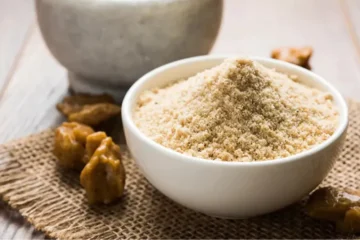1. How does hing enhance the flavor and digestive benefits of Gujarati kadhi?
Summary: Hing (asafoetida) adds a deep umami flavor to Gujarati kadhi, complementing its tanginess while offering digestive benefits by reducing bloating and aiding gut health.
Detailed Explanation:
- Hing is an aromatic resin known for its strong, pungent flavor that mellows into an earthy umami taste when cooked.
- Its digestive properties prevent bloating, gas, and indigestion, making it a staple in many Indian dishes.
- It stimulates digestive enzymes, ensuring smoother digestion of gram flour and yogurt-based dishes.
- Hing works as a natural appetite stimulant and supports gut bacteria, improving overall digestion.
- Combining hing with kadhi enhances its depth of flavor while ensuring optimal digestion of the yogurt’s probiotics.
2. What makes Gujarati kadhi different from other regional kadhi variations?
Summary: Gujarati kadhi is thinner, slightly sweet, and uses jaggery or sugar. It differs from North Indian kadhi, which is thicker, spicier, and contains pakoras.
Detailed Explanation:
| Type of Kadhi | Consistency | Flavor Profile | Main Ingredients |
|---|---|---|---|
| Gujarati Kadhi | Thin | Tangy, Sweet | Yogurt, Gram Flour, Jaggery, Hing |
| Punjabi Kadhi | Thick | Spicy, Sour | Gram Flour, Yogurt, Pakoras, Spices |
| Rajasthani Kadhi | Moderate | Spicy | Gram Flour, Yogurt, Red Chilies, Garlic |
- Gujarati kadhi has a thinner consistency compared to Punjabi and Rajasthani kadhi.
- It balances sweet and tangy flavors by incorporating jaggery and mild spices.
- While other regional kadhi dishes are served with fried pakoras, Gujarati kadhi is often paired with plain rice or khichdi.
- It relies on mustard seeds, cumin, curry leaves, and hing to develop a fragrant yet mild taste.
3. Can hing help with digestion, and is it traditionally used in kadhi for this reason?
Summary: Hing is used in Gujarati kadhi primarily for its digestive benefits, reducing gas, bloating, and promoting enzyme activity.
Detailed Explanation:
- Hing has been a part of Indian cuisine for centuries due to its ability to soothe the digestive tract.
- It improves gut health by preventing the formation of gas and ensuring food is digested more efficiently.
- Traditionally, it was used in kadhi and lentil-based dishes to counteract the heaviness of legumes and dairy.
- Its antibacterial and anti-inflammatory properties also help in keeping intestinal infections at bay.
4. What are the best ways to balance the tangy and spicy flavors in Gujarati kadhi?
Summary: Balancing kadhi’s flavors requires adjusting yogurt’s sourness with jaggery and controlling spices for a mild yet flavorful taste.
Detailed Explanation:
- Use fresh yogurt to avoid excessive sourness; older yogurt can make kadhi overly tangy.
- Incorporate jaggery or sugar in small quantities to balance the sour and sweet notes.
- Use mild spices like curry leaves, mustard seeds, cumin, and green chilies to enhance the kadhi without overpowering its taste.
- Cooking the kadhi on low heat ensures that flavors meld perfectly, creating a harmonious taste.
5. Are there any Ayurvedic benefits of using hing in kadhi, especially for gut health?
Summary: Hing has Ayurvedic properties that help digestion, reduce inflammation, and aid in detoxification, making it an ideal ingredient for kadhi.
Detailed Explanation:
- Hing is a staple in Ayurveda, known to pacify Vata and Kapha doshas, helping balance digestion.
- It works as an anti-inflammatory agent, reducing irritation in the gut.
- Hing detoxifies the body, eliminating harmful bacteria and ensuring a healthy gut microbiome.
- Regular consumption helps prevent acidity and reduces the likelihood of digestive disorders.
Conclusion
Gujarati kadhi with hing is a delightful blend of tangy, sweet, and fragrant flavors, enriched with digestive and Ayurvedic benefits. Hing plays a crucial role in making this dish both flavorful and gut-friendly. Whether for taste or wellness, adding hing to kadhi creates an authentic culinary experience, packed with traditional goodness.





